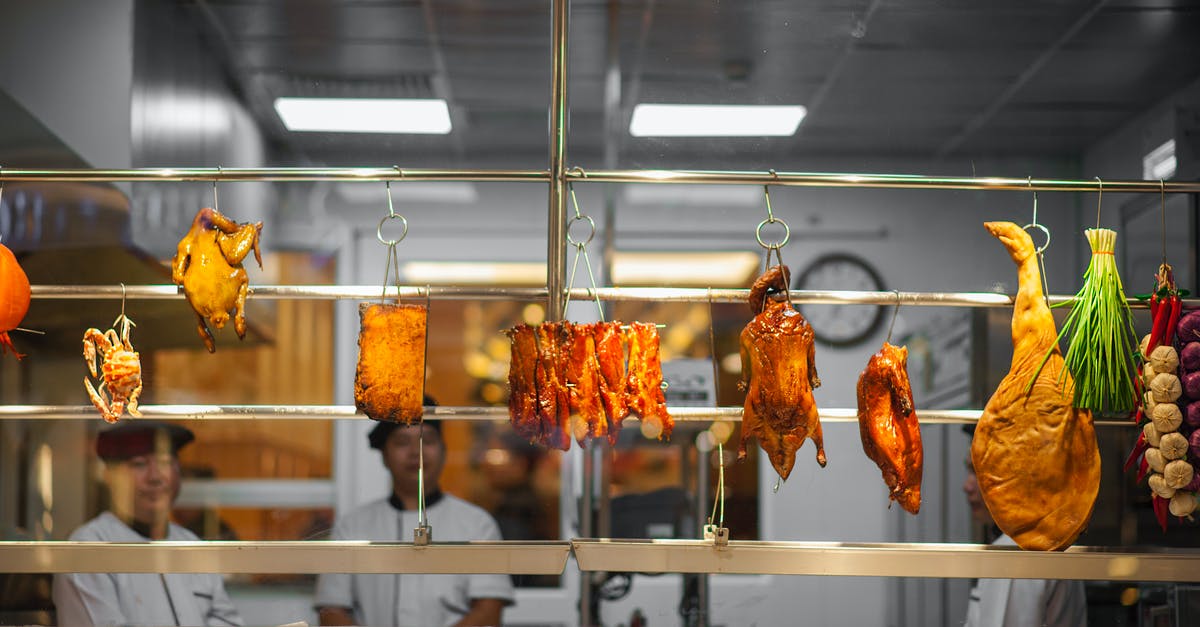I would like to make my own Chicken Stock, any suggestions?

I am tired of using canned broth/stock and would like to make my own - any suggestions as to the proper technique and parts to use?
Best Answer
Note that for maximum benefit I am answering the question regarding chicken stock first and at the end have included information on other stocks such as fish and brown chicken and veal stock.
Properly made stock is made from bones only. If you cut up your own chickens then save the backs and wing tips in the freezer and use for stock. You might ask at your grocery store or butcher and be able to purchase backs from them if you want to make stock but don't have enough. Chicken feet are rich in gelatin and can be added to the pot to help add body to the stock.
Place chicken backs/wing tips in a large stockpot (about a 3-4 gal. stockpot). Cover with cold water and place on stove. Bring to a gentle simmer for about 10 minutes. This is known as "blanching" the bones and is done to help dissolve the blood and other loose proteins from the soft bones. These proteins will form a gray scum on the surface. Once the scum has formed, drain off the water disarding it in the sink. The more clear a stock is the longer the shelflife as it's the additional proteins making a stock cloudy that also cause it to spoil much more quickly.
Return bones to the pot and cover again with cold water. Add a sachet (cheesecloth pouch containing a couple of bay leaves, about a teaspoon of whole peppercorns, a handful of parsley stems, and 8-10 thyme branches or a teaspoon of dried thyme) that's been tied up with some string. Bring the pot to a very gentle simmer once again and allow to simmer for about 3 hours.
After 3 hours add the mirepoix (carrots, onions, celery). Plan on 1-2 lbs. of mirepoix (combined vegetables) per 8 lbs. of bones. I also like to add leeks as they not only add flavor but are supposed to help in clarification of the stock. Continue to simmer the stock for 1-2 hours. (If you're not going to be around to add the vegetables at that time they can be added with the bones but need to be cut in large pieces to avoid cooking down and disintegrating. I would typically start chicken and veal stock at night before leaving the restaurant and allow it to simmer overnight until the next morning.)
Strain the stock through a fine mesh strainer or several layers of cheesecloth. Cool the stock in a metal container (another pot) in an ice bath until cool to the touch and then place in storage containers and refrigerate or freeze.
Once the stock has chilled the fat will have formed a solid layer on top of the stock. Carefully remove and either discard or use for sauteeing (such as duck or chicken fat).
Additional Notes: The same process would be followed for white veal stock (not frequently used)
If preparing a brown stock (roasted chicken, veal, beef, lamb, duck):** These stocks are made by first rinsing the bones and then roasting in the oven at about 400 F degrees until medium brown (think iced tea color).
Once bones are browned, smear them with a tablespoon or two of tomato paste and roast for another 5 minutes or so. Be careful as the concentrated sugars in the tomato paste can cause it to burn and create a bitter tasting stock.
After bones and tomato paste have roasted, place them in the stock pot and add the mirepoix to the roasting pan, tossing to coat with the fat that has rendered out and roast the mirepoix until lightly browned. Add the mirepoix about 2 hours before finishing the stock. Be sure carrots are cut rather large to avoid having them disintegrate and adding a strange excessively sweet taste to the stock.
Recommended cooking times for stocks:
-Fish: 30-45 minutes. Use lean white fish bones and heads. Lobster/shrimp stock is made from the shells and will usually yield more flavor if first roasted. Remove gills and eyes from fish heads to prevent clouding the stock. Do not use carrots in mirepoix or it will color the stock an orange hue. Use onions, celery, leeks, mushrooms, and sliced lemon.
-Chicken/Duck: 4-6 hours
-Veal/Beef/Lamb: 8-12 hours (knuckle bones of veal will have the greatest amount of gelatin since the bones haven't hardened as much as those of beef)
Stocks should not be seasoned with salt as one of the primary purposes is for them to be a "stock" item that can be used for a variety of needs: soups, sauces, rice, etc. The salt is added to the final preparation not the stock. If stock is salted and then used for a reduction sauce the resulting sauce will be too salty.
Pictures about "I would like to make my own Chicken Stock, any suggestions?"



What are the basic ingredients to making a good stock?
5 Ingredients to Add to Your Stocks- Bones. Chicken and pork bones are often used in preparing stocks as they're easy to find. ...
- Vegetable scraps. If you've been throwing away scraps from tomatoes, onion peels, and the tops (or bottoms) of certain vegetables, stop. ...
- Apple cider vinegar. ...
- Something spicy. ...
- Herbs.
Is it worth making your own chicken stock?
It's easy to grab chicken stock off the grocery store shelf. But if you make lots of soups and stews at home, having the homemade stuff on hand is decidedly worth it: It's cost effective, and with a robust chicken flavor and tons of nutrients, it tastes infinitely better than anything from the supermarket.What is the difference between chicken stock and chicken broth?
Though their ingredients are largely the same, there is a difference between them. Stock is made from bones, while broth is made mostly from meat or vegetables. Using bones in stock creates a thicker liquid, while broth tends to be thinner and more flavorful.More answers regarding i would like to make my own Chicken Stock, any suggestions?
Answer 2
I find whole chickens to be cheaper than the parts (wings, backs, whatever), so I regularly buy a couple whole birds, chop the breasts out (saving for later use), and then make stock with the remaining meat/bones/skin.
Place the chicken in a stock pot. Add a couple onions, carrots, celery stalks and some peppercorns. Cover with cold water. Bring to a bare simmer and cook for 2-3 hours. For ease, I usually bring the pot to a boil on the stove top, and then transfer to the oven at 250.
Strain the stock, chill, and then freeze for later use.
Answer 3
I serve rotisserie chicken once in a while - I save the bones in the freezer until I have enough to make a big batch of stock. I also save the tops and bottoms of celery stalks and other trimmings when I make veggie trays. The veg may get mushy from freezing but it still has great flavor to add to your stock. I find that for home use freezing the stock in 1-cup increments works great.
Answer 4
I'd also add that if you have access to a pressure cooker, you can make stock more quickly and have the added benefit of it staying more clear instead of getting cloudy. I also personally think it tastes better.
Answer 5
Darens' recipe sounds lovely, if you are after a proper stock.
Here is a quick cheap alternative.
Freeze the bones and skin of a roast chicken once you have finished with them.
When you need some quick stock, put the bits into a pan and cover with boiling water.
Simmer for half an hour or so and then use a sieve to keep the bits behind..
Answer 6
We had this problem when my youngest started having food allergies. The quick and dirty method I use, which is easy, but not as fancy as some of the others here, is as follows: buy a 10 lb bag of chicken leg and thigh quarters. put in as big a pot as I can and cover with water. Add 1 tblsp. of poultry seasoning or Mrs. Dash original. Bring to a boil then reduce heat and simmer for about an hour. pull the chicken quarters out reserving the liquid, strip the meat, which should come off easy. Toss the bones back into the pot with the reserved liquid and some of the skin and simmer for another hour or 2. Strain and portion into 1 cup units and toss in the freezer.
The chicken I pulled off I use for things like chicken salad, barbeque chicken sandwiches, and for a comfort food like chicken and rice. for the chicken and rice: 1 cup frozen chicken broth(or stock, or whatever), 1 cup rice, enough liquid to make the up the difference in liquid for the rice. When the rice is done, add 1 cup chicken, salt and pepper to taste. You can add a can of cream of chicken soup as well, but It's fine without.
Good luck!
edit side note, I have taken to using a pair of shears to cut the long bones in half before taossing them back into the pot. I think it deepens the flavor
Answer 7
In general, the parts of the animal to be used in making stock depends on the animal:
For chickens, different people will recommend different parts of the animal, but simply chopping up an entire chicken works fairly well.
For beef, pretty much any tough piece of meat will work; try looking at shoulder or butt.
As for other suggestions, be creative! Almost anybody can make a basic broth by boiling a chicken, but making one that is truly fantastic takes time and work. Try adding different ingredients. For starters, try things that you are familiar with. For example, vegetables and herbs like garlic and basil can improve any broth. From there, try things that are more creative, like sesame oil, miso paste, or perhaps ginger.
Answer 8
One suggestion I would add is to freeze your stock in ice-cube trays, or in other small portions, so that you can parcel out the amount you need when you need it.
Answer 9
We start with our older laying hens & roosters. remove Head, dip in boiling water pluck chicken. Next gut. Place aside giblets. Wash in cold well water. Place in large pressure cooker. With salt, onion chopped, garlic, pepper, morening leaf. Feet may be left on. Cook 4 to 6 hours till meat falls of bones. Cool. remove grease from top. Remove all bones. Large chunks of chicken cut up. Taste broth. You may wish to add more spice. Put pot back on stove boil to reduce till you have flavor you wish. Cool. Put in bags. Remove all air. Use masking tape & pen to label bags. Freeze till needed. The secret to good chicken stock is to not use fryers or bakers but your older chickens free range ones.
Sources: Stack Exchange - This article follows the attribution requirements of Stack Exchange and is licensed under CC BY-SA 3.0.
Images: Skylar Kang, Hank, Andrea Piacquadio, Min An
